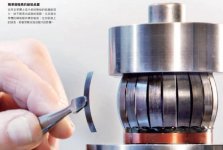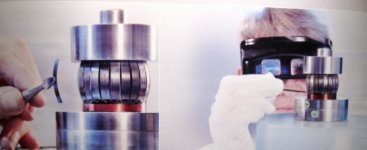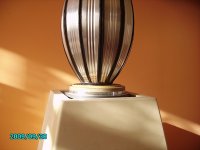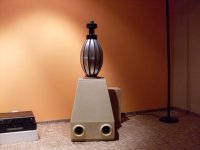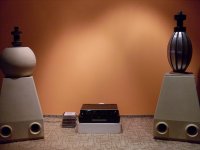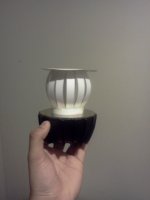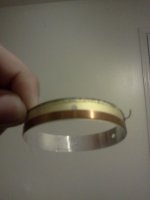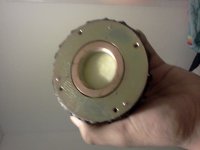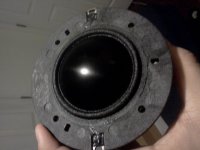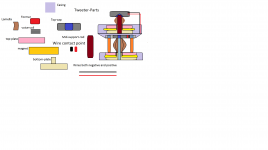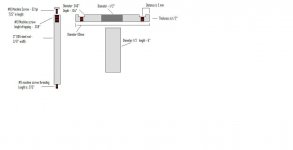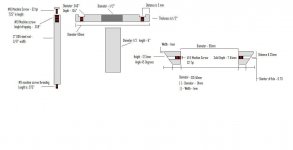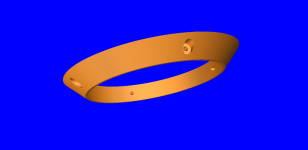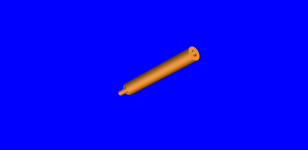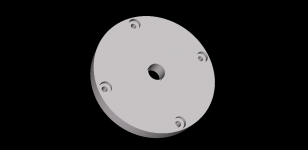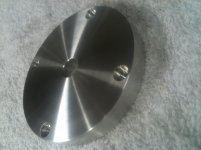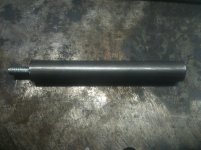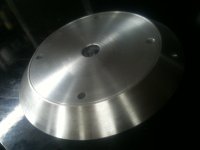I have a good 2 months out of school and i decided to build a replication of the loudspeakers MBL 101 mkII. The monetary resources to build a clone at least parts of it are taken care of . The following are the complete information of construction regarding the MBL 101 mkII. This project is inspired by this thread My MBL 101E replicas
DELAYED
The Tweeter :
Number Of Petals - 24
Lamella Material - Uni-Directional Carbon Fiber
Lamella - 24mm x Unknown
Lamella Bending Radius - 25mm
Lamella Type - Non-Stitched Epoxy Bonded
Lamella Resin - MGS System 285 (H287S MGS HARDENER SLOW)
Lamella - Bake Temperature And Pressure Unknown
Lamella Prepeg ratio - 54% Carbon Fiber 46% Epoxy Resin
Lamella Glue - unknown
Dampening - Polyester Fiber (Twaron Angel hair)
Top Cap - W x 44.45mm
Top Cap Hole Diameter - Unknown
Mid Support Rod - W x L Unknown
Voice coil - Diameter 37mm ( 3.7cm )
Voice coil/Former - 4n Copper Wiring Used
Voice coil/Former - Aluminum Former Used
Voice coil/Former- Glue used is car break glue ''burned in at 500 Fahrenheit''
Voice coil/Former - Floats In Ferrofluid
Top Plate Diameter - 120.40mm
Bottom Plate Diameter - Unknown
Magnetic Material - Neodymium
Magnet size - 70mm ( 7cm )
IN-PROGRESS
The Mid-Range :
Number of petals - 12
Lamella material - Cross-Woven Carbon-Fiber
Lamella Tow - 1K
Lamella Type - Spread tow ( PrimeTex ZB )
Lamella cut - Bias
Lamella - 12.5mm x 1 sheet x 62mm
Lamella Bending Radius - 55mm
Lamella Resin - MGS System 285 (H287S MGS HARDENER SLOW)
Lamella - Bake Temperature 176F And Pressure 200psi
Lamella Prepeg Ratio - 54% Carbon Fiber 46% Epoxy Resin
Lamella Glue - Silicon Rubber Glue (Wacker)
Dampening - Polyester Fiber (Twaron Angel Hair)
Inner Ring- 40mm x 12.5mm
Inner-Ring Material - AL-MG ( Aluminum/Magnesium)
Inner-Ring Hole Diameter - 13mm
Outer-Ring - 90 x 12.5mm
Outer-Ring Material - AL-MG ( Aluminum/Magnesium)
Outer ring Hole diameter - 9.525mm ( 3/8" )
Inner-Hollow pass through -Rod - (OD)13mm x 5"
Inner-Hollow pass through -Rod (ID) 6.25mm
Inner-Hollow pass through -Rod Material - Graphite
Outer-Steel Support-Rod - 9.525mm ( 3/8" ) x 60mm ( 6cm )
Outer-Support-Rod Material - Super-Refined Steel
Voice coil Diameter - 5cm ( 50mm )
Voice coil/Former - 4n copper wiring used
Voice coil/Former - Kapton former used
Voice coil/Former- Glue used is car break glue ''burned in at 500 Fahrenheit''
Voice coil/Former - Floats In Ferro-Fluid
Top Plate Diameter - Unknown
Bottom Plate Diameter - Unknown
Magnet material - Neodymium
Magnet size - 12cm ( 120mm )
Delayed
The Melon :
Number of petals - 12
Lamella material - an alloy of Aluminum,magnesium,and silicon
Alloy ratio - Unknown
Lamella - Raw 50mm widest point x 20mm at end points x D x 360mm
Lamella - Assembled 10in x D x 16.5in with a lamella end of 4inch
Lamella Glue - Silicon Rubber
Lamella Bending Radius - Unknown
Dampening - Polyurethane Foam/Polyester Fiber
Copper Rods - L x W Unknown
Top Cap - W x D x L Unknown
Top Cap Hole Diameter -Unknown
Mid- Hollow -Rod - W x D x L Unknown
Voice coil Diameter - 100mm OD (10cm)
Voice coil/Former - 4n copper wiring used Likely
Voice coil/Former- Glue used is car break glue Likely
Voice coil/Former - Former Used Unknown
Voice coil/Former - floats in Ferrofluid likely
Magnetic Material - Ferrite
Magnet size - 200mm OD (20cm)
Spider ID-OD - 100mm (10cm)
The aluminum lamellas are a sandwich construction of two aluminum wedges held with epoxy resin Wrong. The petals are given 2 days to cool like airplane parts. layers of polyurethane foam are slapped on the back of each lamella to provide damping and additional mass. Each lamella is fitted with 2 thick reddish copper ''wires''. The wires are fitted into the vertical recesses of the petal. The wires add mass and an aesthetic beauty. The recesses of the driver are rolled and not stamped. The whole assembly rest on a cast aluminum plinth coated in automotive grade atracite metallic paint.
The sub woofer
[FONT=Verdana, Arial, Helvetica, sans-serif][SIZE=-1]The woofer is a 12" driver with a 4" voice coil. The voice coil is composed of black anodized aluminum that has a very low thermal resistance, approximately 1 K/W. This gives the system large power handling capability. The voice coil wire is also constructed of high temperature material able to withstand temperatures of up to 360¡C. The wire is glued with the same glue used in the fabrication of motorcycle brakes, and is able to withstand a temperature of 260¡C. As a result, it is almost impossible to destroy the speaker. The air gap is 10 mm high and the moving coil has a winding width of 24 mm. Thus, the speaker possesses an extremely high linear throw, with a maximum of 14-mm peak to peak. The maximum mechanical throw is two times greater -- 28 mm maximum peak to peak.[/SIZE][/FONT]
The cabinet :
Material - MDF
Material thickness - 30mm (1.25")
Port Holes - 2 inches in Diameter
Additional cabinet info
the cabinet has rectangular cross configuration to both stabilize the walls and hold the magnet with polyurethane supports.
specifications:
Crossover frequencies: 105Hz, 600Hz, 3.5kHz (Linkwitz-Riley, fourth-order). Acoustic center: 45" (1140mm) from floor. Frequency range: 24Hz–40kHz. Sensitivity: 81dB/2.83V/m. Nominal impedance: 4 ohms. Power handling: 320–500W continuous, 2.2kW peak.
Right now i am hopping to simply replicate the mid-range and used them as my stereo setup and as research and design along with resources progress the replication of the other 2 drivers will begin. I am learning to use Femm so that i can design and build the magnetic circuit for the mid range.The processes for building the mid range will hopefully be done in parts such as
Step 1 : Magnetic circuit fully designed and optimized in femm
Step 2 : ferrofluid properties such as viscosity,heat tolerance,and Gauss rating can then be calculated
Step 3 : Carbon fiber baking methods can be R&D
Please tell me your thoughts on such a project
DELAYED
The Tweeter :
Number Of Petals - 24
Lamella Material - Uni-Directional Carbon Fiber
Lamella - 24mm x Unknown
Lamella Bending Radius - 25mm
Lamella Type - Non-Stitched Epoxy Bonded
Lamella Resin - MGS System 285 (H287S MGS HARDENER SLOW)
Lamella - Bake Temperature And Pressure Unknown
Lamella Prepeg ratio - 54% Carbon Fiber 46% Epoxy Resin
Lamella Glue - unknown
Dampening - Polyester Fiber (Twaron Angel hair)
Top Cap - W x 44.45mm
Top Cap Hole Diameter - Unknown
Mid Support Rod - W x L Unknown
Voice coil - Diameter 37mm ( 3.7cm )
Voice coil/Former - 4n Copper Wiring Used
Voice coil/Former - Aluminum Former Used
Voice coil/Former- Glue used is car break glue ''burned in at 500 Fahrenheit''
Voice coil/Former - Floats In Ferrofluid
Top Plate Diameter - 120.40mm
Bottom Plate Diameter - Unknown
Magnetic Material - Neodymium
Magnet size - 70mm ( 7cm )
Tweeter
Additional Known Driver Info
The outside of the lamellas are coated with a thin anti resonance film. The inside of the circular lamella configuration is filled with sound absorbing fibers witch have been confirmed to be of polyester origin.
IN-PROGRESS
The Mid-Range :
Number of petals - 12
Lamella material - Cross-Woven Carbon-Fiber
Lamella Tow - 1K
Lamella Type - Spread tow ( PrimeTex ZB )
Lamella cut - Bias
Lamella - 12.5mm x 1 sheet x 62mm
Lamella Bending Radius - 55mm
Lamella Resin - MGS System 285 (H287S MGS HARDENER SLOW)
Lamella - Bake Temperature 176F And Pressure 200psi
Lamella Prepeg Ratio - 54% Carbon Fiber 46% Epoxy Resin
Lamella Glue - Silicon Rubber Glue (Wacker)
Dampening - Polyester Fiber (Twaron Angel Hair)
Inner Ring- 40mm x 12.5mm
Inner-Ring Material - AL-MG ( Aluminum/Magnesium)
Inner-Ring Hole Diameter - 13mm
Outer-Ring - 90 x 12.5mm
Outer-Ring Material - AL-MG ( Aluminum/Magnesium)
Outer ring Hole diameter - 9.525mm ( 3/8" )
Inner-Hollow pass through -Rod - (OD)13mm x 5"
Inner-Hollow pass through -Rod (ID) 6.25mm
Inner-Hollow pass through -Rod Material - Graphite
Outer-Steel Support-Rod - 9.525mm ( 3/8" ) x 60mm ( 6cm )
Outer-Support-Rod Material - Super-Refined Steel
Voice coil Diameter - 5cm ( 50mm )
Voice coil/Former - 4n copper wiring used
Voice coil/Former - Kapton former used
Voice coil/Former- Glue used is car break glue ''burned in at 500 Fahrenheit''
Voice coil/Former - Floats In Ferro-Fluid
Top Plate Diameter - Unknown
Bottom Plate Diameter - Unknown
Magnet material - Neodymium
Magnet size - 12cm ( 120mm )
Mid-Range
Additional Known Driver Info
The thrust bearing is a single side coated with a heavy tar plate to reduce resonance. The inside of the lamella group is coated with a special rubber material, and thin anti resonance film is also applied to the lamellas. The four rods are super refined steel. Both ends of the lamellas are glued using the silicon rubber glue, all the lamellas are glue together with a bead. polyester fiber fills the inside, and is sealed off by a rubber material.
Delayed
The Melon :
Number of petals - 12
Lamella material - an alloy of Aluminum,magnesium,and silicon
Alloy ratio - Unknown
Lamella - Raw 50mm widest point x 20mm at end points x D x 360mm
Lamella - Assembled 10in x D x 16.5in with a lamella end of 4inch
Lamella Glue - Silicon Rubber
Lamella Bending Radius - Unknown
Dampening - Polyurethane Foam/Polyester Fiber
Copper Rods - L x W Unknown
Top Cap - W x D x L Unknown
Top Cap Hole Diameter -Unknown
Mid- Hollow -Rod - W x D x L Unknown
Voice coil Diameter - 100mm OD (10cm)
Voice coil/Former - 4n copper wiring used Likely
Voice coil/Former- Glue used is car break glue Likely
Voice coil/Former - Former Used Unknown
Voice coil/Former - floats in Ferrofluid likely
Magnetic Material - Ferrite
Magnet size - 200mm OD (20cm)
Spider ID-OD - 100mm (10cm)
Melon
Additional Driver Info
Additional Driver Info
The aluminum lamellas are a sandwich construction of two aluminum wedges held with epoxy resin Wrong. The petals are given 2 days to cool like airplane parts. layers of polyurethane foam are slapped on the back of each lamella to provide damping and additional mass. Each lamella is fitted with 2 thick reddish copper ''wires''. The wires are fitted into the vertical recesses of the petal. The wires add mass and an aesthetic beauty. The recesses of the driver are rolled and not stamped. The whole assembly rest on a cast aluminum plinth coated in automotive grade atracite metallic paint.
The sub woofer
[FONT=Verdana, Arial, Helvetica, sans-serif][SIZE=-1]The woofer is a 12" driver with a 4" voice coil. The voice coil is composed of black anodized aluminum that has a very low thermal resistance, approximately 1 K/W. This gives the system large power handling capability. The voice coil wire is also constructed of high temperature material able to withstand temperatures of up to 360¡C. The wire is glued with the same glue used in the fabrication of motorcycle brakes, and is able to withstand a temperature of 260¡C. As a result, it is almost impossible to destroy the speaker. The air gap is 10 mm high and the moving coil has a winding width of 24 mm. Thus, the speaker possesses an extremely high linear throw, with a maximum of 14-mm peak to peak. The maximum mechanical throw is two times greater -- 28 mm maximum peak to peak.[/SIZE][/FONT]
For this i hope to substitute for this driver
TC Sounds Axis 12Q1 12" Quad VC Subwoofer 293-638
TC Sounds Axis 12Q1 12" Quad VC Subwoofer 293-638
The cabinet :
Material - MDF
Material thickness - 30mm (1.25")
Port Holes - 2 inches in Diameter
Additional cabinet info
the cabinet has rectangular cross configuration to both stabilize the walls and hold the magnet with polyurethane supports.
specifications:
Crossover frequencies: 105Hz, 600Hz, 3.5kHz (Linkwitz-Riley, fourth-order). Acoustic center: 45" (1140mm) from floor. Frequency range: 24Hz–40kHz. Sensitivity: 81dB/2.83V/m. Nominal impedance: 4 ohms. Power handling: 320–500W continuous, 2.2kW peak.
Right now i am hopping to simply replicate the mid-range and used them as my stereo setup and as research and design along with resources progress the replication of the other 2 drivers will begin. I am learning to use Femm so that i can design and build the magnetic circuit for the mid range.The processes for building the mid range will hopefully be done in parts such as
Step 1 : Magnetic circuit fully designed and optimized in femm
Step 2 : ferrofluid properties such as viscosity,heat tolerance,and Gauss rating can then be calculated
Step 3 : Carbon fiber baking methods can be R&D
Please tell me your thoughts on such a project
Last edited:
Mid-Range naked
Construction of the mid range.
Construction of the mid range.
Attachments
-
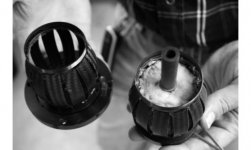 mid-range inner workings.jpg28.1 KB · Views: 1,270
mid-range inner workings.jpg28.1 KB · Views: 1,270 -
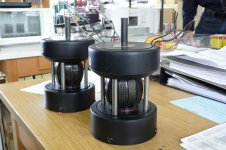 Mbl Mids Single.jpg380.9 KB · Views: 1,258
Mbl Mids Single.jpg380.9 KB · Views: 1,258 -
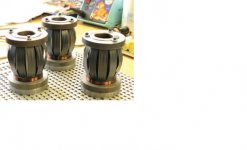 Mbl naked mids 3.jpg27.9 KB · Views: 1,286
Mbl naked mids 3.jpg27.9 KB · Views: 1,286 -
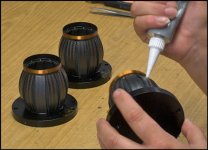 resan8038.jpg43.1 KB · Views: 1,217
resan8038.jpg43.1 KB · Views: 1,217 -
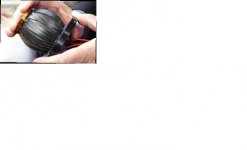 Mbl mid partially asmebled with thrust plate held in place.jpg14.9 KB · Views: 892
Mbl mid partially asmebled with thrust plate held in place.jpg14.9 KB · Views: 892 -
 Mbl mid the petals are glued to the voice coil and thrust plate.jpg14.8 KB · Views: 1,108
Mbl mid the petals are glued to the voice coil and thrust plate.jpg14.8 KB · Views: 1,108 -
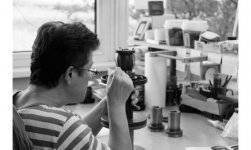 MBl assembly of the mid-range.jpg33.4 KB · Views: 3,583
MBl assembly of the mid-range.jpg33.4 KB · Views: 3,583 -
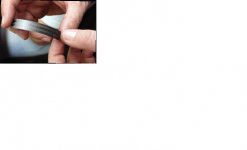 Mbl mid - computer cut lamnella.jpg13.1 KB · Views: 3,560
Mbl mid - computer cut lamnella.jpg13.1 KB · Views: 3,560 -
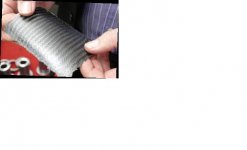 Mbl mid Baked sheet of carbon fiber.jpg18.7 KB · Views: 3,654
Mbl mid Baked sheet of carbon fiber.jpg18.7 KB · Views: 3,654
The Melon naked
The Melon construction
The Melon construction
Attachments
-
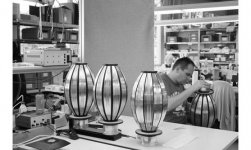 putting on lamellas.jpg44.9 KB · Views: 911
putting on lamellas.jpg44.9 KB · Views: 911 -
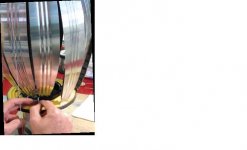 mbl melon beinge flued to thrust plate and motor sytem.jpg25 KB · Views: 970
mbl melon beinge flued to thrust plate and motor sytem.jpg25 KB · Views: 970 -
 Mbl Naked 6.JPG152.3 KB · Views: 968
Mbl Naked 6.JPG152.3 KB · Views: 968 -
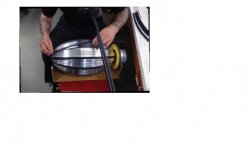 mbl melon the black elastic bands are being put on and so is external dampening.jpg20 KB · Views: 1,014
mbl melon the black elastic bands are being put on and so is external dampening.jpg20 KB · Views: 1,014 -
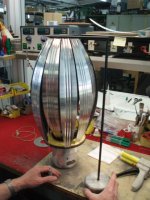 mbl naked 4.JPG158.2 KB · Views: 1,112
mbl naked 4.JPG158.2 KB · Views: 1,112 -
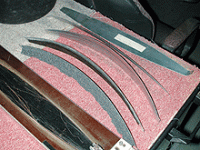 Mbl melon parts.gif37.6 KB · Views: 903
Mbl melon parts.gif37.6 KB · Views: 903 -
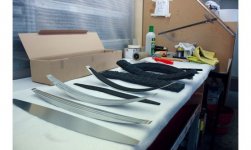 showing dampening.jpg36.3 KB · Views: 812
showing dampening.jpg36.3 KB · Views: 812 -
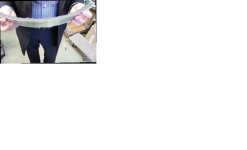 Mbl melon lamnella after dampening has been applied.jpg14.9 KB · Views: 745
Mbl melon lamnella after dampening has been applied.jpg14.9 KB · Views: 745 -
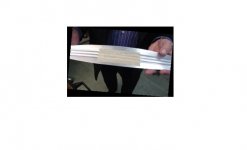 Mbl melon lamnella after rolled corrigation.jpg14.2 KB · Views: 907
Mbl melon lamnella after rolled corrigation.jpg14.2 KB · Views: 907 -
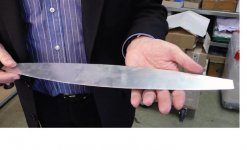 Mbl melon lamnella.jpg34.9 KB · Views: 1,182
Mbl melon lamnella.jpg34.9 KB · Views: 1,182
The Melon naked Con't
The melon construction
The melon construction
Attachments
-
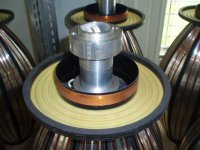 mbl melon naked 3.JPG155.6 KB · Views: 791
mbl melon naked 3.JPG155.6 KB · Views: 791 -
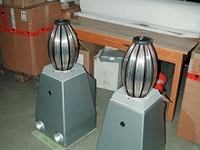 Mbl head cut off.gif31.7 KB · Views: 757
Mbl head cut off.gif31.7 KB · Views: 757 -
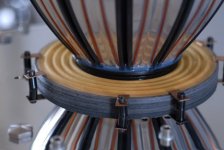 showing spider.jpg28 KB · Views: 771
showing spider.jpg28 KB · Views: 771 -
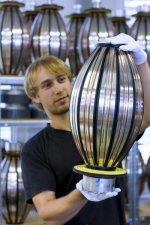 Guy holding completed Melon.JPG39.7 KB · Views: 924
Guy holding completed Melon.JPG39.7 KB · Views: 924 -
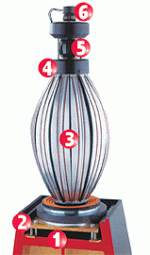 MBL naked all.gif21.2 KB · Views: 616
MBL naked all.gif21.2 KB · Views: 616 -
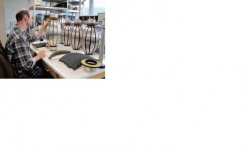 Mbl naked melons 8.jpg21.7 KB · Views: 561
Mbl naked melons 8.jpg21.7 KB · Views: 561 -
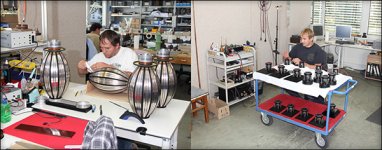 mbl_rundstralere_11.jpg127.5 KB · Views: 834
mbl_rundstralere_11.jpg127.5 KB · Views: 834 -
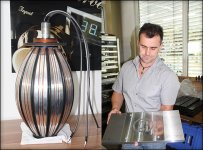 melon wires.jpg161.3 KB · Views: 803
melon wires.jpg161.3 KB · Views: 803 -
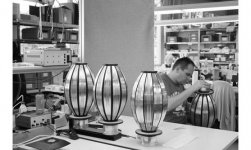 putting on lamellas.jpg44.9 KB · Views: 582
putting on lamellas.jpg44.9 KB · Views: 582 -
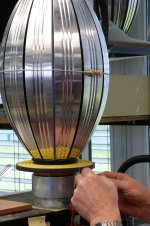 Adjusting voice coil wire.jpg368.1 KB · Views: 966
Adjusting voice coil wire.jpg368.1 KB · Views: 966
Driver choice
Mid Range is the Dayton Audio Rs52an-8 2" Dome Mid range.
Mid Range is the Dayton Audio Rs52an-8 2" Dome Mid range.
Attachments
Last edited:
Dayton Anotomy
Dayton mid range taken apart.
Dayton mid range taken apart.
Attachments
Last edited:
Models of drivers
A MS paint illustration showing mid range driver components.
A MS paint illustration showing mid range driver components.
Attachments
Last edited:
I,m amazed by the use of copper for the melons. You would think something lighter would work out better and add some sensitivity along the way.
But then again, when you have house amps this size who cares!
Regards
David
But then again, when you have house amps this size who cares!
Regards
David
Magnasanti,
Thanks for answering my questions on the other thread. It sounds like you have a good approach - make the metallic base parts that the lamellas attach to before making the lamellas, otherwise you won't be able to test the lamellas. That's great you have made the mold for the lamellas though. The mold is the hard part, as the fun part is actually making the parts from the mold.
Once you said 'samurai' carbon fiber, I immediately though pressurized/heat setting, but you already have a plan to vacuum bag and cure it in the oven. Do you have the compresser and bag equipment? What type of oven are you using to heat set these parts? I have some equipment at work I can use (compresser, bags, all types of ovens, mill, lathe), otherwise most of this work is done in my garage haha. I do not plan on using fiberglass for my cones, but it's cheap and I wanted to see what I was working with before spending more on aerospace grade carbon fiber or pre-pregs (many types of fiber materials her: www.hexcel.com). The only other fiberglass work I've done before this was repairing surfboards.
So you had to purchase a driver specifically for it's voice coil and magnet? Is it the Dayton Audio RS52AN listed in another one of your posts? I'm still on the look for voice coil sources, but it may be cheaper to buy cheap speakers from parts-express.com or wherever.
Thanks for answering my questions on the other thread. It sounds like you have a good approach - make the metallic base parts that the lamellas attach to before making the lamellas, otherwise you won't be able to test the lamellas. That's great you have made the mold for the lamellas though. The mold is the hard part, as the fun part is actually making the parts from the mold.
Once you said 'samurai' carbon fiber, I immediately though pressurized/heat setting, but you already have a plan to vacuum bag and cure it in the oven. Do you have the compresser and bag equipment? What type of oven are you using to heat set these parts? I have some equipment at work I can use (compresser, bags, all types of ovens, mill, lathe), otherwise most of this work is done in my garage haha. I do not plan on using fiberglass for my cones, but it's cheap and I wanted to see what I was working with before spending more on aerospace grade carbon fiber or pre-pregs (many types of fiber materials her: www.hexcel.com). The only other fiberglass work I've done before this was repairing surfboards.
So you had to purchase a driver specifically for it's voice coil and magnet? Is it the Dayton Audio RS52AN listed in another one of your posts? I'm still on the look for voice coil sources, but it may be cheaper to buy cheap speakers from parts-express.com or wherever.
- Home
- Loudspeakers
- Planars & Exotics
- Summer Project - Replication of MBL loudspeaker 101mkII
